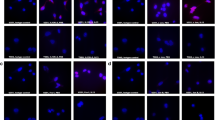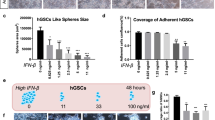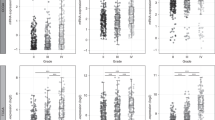Summary
The precise mechanisms governing the direct effect of IFN-β, including apoptosis induction, are not yet fully understood. To gain a better insight into these mechanisms, we investigated the signaling pathways focusing particularly on interferon regulatory factor 1 (IRF-1) and IRF-2 in glioblastoma cell lines. Furthermore, we attempted to determine whether or not IRF-1 and IRF-2 act as additional prognostic indicators in diffusely infiltrating astrocytomas (DIA). We first assessed the cytotoxic effects of IFN-β based on a cell growth study and modified MTT assay, and then quantified the apoptosis using a sandwich enzyme immunoassay following IFN-β treatment in the cell lines, U-87MG, T98G, and A-172. Subsequently, we carried out an analysis of apoptosis-related molecules as evaluated by densitometric analysis of Western blots, focusing on IRF-1 and IRF-2, and two major initiator caspases, caspase-8 and caspase-9. Furthermore, we assessed the expression of type I IFN receptor, IRF-1, and IRF-2 using immunohistochemical techniques in 63 DIA (15 of WHO grade II, 18 of grade III, and 30 of grade IV), and analyzed their impact on prognosis. An increase in apoptosis was apparent after 48 h of IFN-β treatment (1 × 104 IU/ml) in T98G but not in U-87MG or A-172. IFN-β treatment for 6 h significantly enhanced the expression of IRF-1 in all three cell lines. However, an enhanced expression of IRF-2 was observed only in the not-most-sensitive, non-apoptosis-induced U-87MG and A-172. While minimal processing of caspase-8 was noted in the three cell lines throughout the experiment, caspase-9 activation was observed in the apoptosis-detected T98G after 48 h of treatment, as indicated by a 1.33-fold increase (P=0.037). On the other hand, the IRF-1 LI and IRF-1/IRF-2 LI ratio were greater in low-grade DAI, and were negatively correlated with the histopathological grade in DIA (P=0.017 and P=0.001, respectively). Furthermore, the IRF-1/IRF-2 LI ratio was negatively correlated with the MIB-1 LI in DIA (P=0.004), and represented an independent and most powerful determinant of overall survival compared to other conventional prognostic factors (P=0.018). However, the relation was not statistically significant when only patients with high-grade DIA were assessed. Our findings suggest that up-regulation of IRF-1 and IRF-2 might be an important determinant of susceptibility to IFN-β mediated cytotoxicity including apoptosis. Furthermore, the IRF-1/IRF-2 LI ratio may reflect the proliferative state of DIA and constitute an important prognostic marker in DIA. Thus, IRF-1 and IRF-2 could represent one of the therapeutic target sites for the regulation of cell growth in DIA.
Similar content being viewed by others
References
JA Langer S. Pestka (1988) ArticleTitleInterferon receptors Immunol Today 9 393–400 Occurrence Handle10.1016/0167-5699(88)91241-8 Occurrence Handle2475121
GC Sen P. Lengyel (1992) ArticleTitleThe interferon system: a bird’s eye view of its biochemistry J Biol Chem 267 5017–5020 Occurrence Handle1371992
DV Kalvakolanu EC. Borden (1996) ArticleTitleAn overview of the interferon system: signal transduction and mechanisms of action Cancer Invest 14 25–53 Occurrence Handle8597888
SJ Um EJ Kim ES Hwang SJ Kim SE Namkoong JS. Park (2000) ArticleTitleAntiproliferative effects of retinoic acid/interferon in cervical carcinoma cell lines: cooperative growth suppression of IRF-1 and p53 Int J Cancer 85 416–423 Occurrence Handle10.1002/(SICI)1097-0215(20000201)85:3<416::AID-IJC19>3.3.CO;2-V Occurrence Handle10652435
T Watanabe Y Katayama A Yoshino C Komine T Yokoyama T. Fukushima (2003) ArticleTitleTreatment of low-grade diffuse astrocytomas by surgery and human fibroblast interferon without radiation therapy J Neuro-Oncol 61 171–176 Occurrence Handle10.1023/A:1022120325619
J Sanceau J Hiscott O Delattre J. Wietzerbin (2000) ArticleTitleIFN-β induces serine phosphorylation of Stat-1 in Ewing’s sarcoma cells and mediates apoptosis via induction of IRF-1 and activation of caspase-7 Oncogene 13 3372–3383 Occurrence Handle10.1038/sj.onc.1203670
M Chawla-Sarkar DW Leaman EC. Borden (2001) ArticleTitlePreferential induction of apoptosis by interferon(IFN)-β compared with IFN-α2: correlation with TRAIL/Apo2L induction in melanoma cell lines Clin Cancer Res 7 1821–1831 Occurrence Handle11410525
G Romeo G Fiorucci MV Chiantore ZA Percario S Vannucchi E. Affabris (2002) ArticleTitleReview: IRF-1 as a negative regulator of cell proliferation J Interferon Cytokine Res 22 39–47 Occurrence Handle10.1089/107999002753452647 Occurrence Handle11846974
H Harada M Kitagawa N Tanaka H Yamamoto K Harada M Ishihara T. Taniguchi (1993) ArticleTitleAnti-oncogenic and oncogenic potentials of interferon regulatory factor 1 and 2 Science 259 971–974 Occurrence Handle8438157
H Harada T Kondo S Ogawa T Tamura M Kitagawa N Tanaka MS Lamphier H Hirai T. Taniguchi (1994) ArticleTitleAccelerated exon skipping of IRF-1 mRNA in human myelodysplasia: a possible mechanism of tumor suppressor inactivation Oncogene 9 3313–3320 Occurrence Handle7936656
RS Tan T Taniguchi H. Harada (1996) ArticleTitleIdentification of the lysyl oxidase gene as target of the antioncogenic transcription factor, IRF-1, and its possible role in tumor suppression Cancer Res 56 2417–2421 Occurrence Handle8625321
H Harada T Taniguchi N. Tanaka (1998) ArticleTitleThe role of interferon regulatory factors in the interferon system and cell growth control Biochimie 80 641–650 Occurrence Handle10.1016/S0300-9084(99)80017-0 Occurrence Handle9865486
PS Vaughan CM Meijden Particlevan der F Aziz H Harada T Taniguchi AJ Wijnen Particlevan JL Stein GS. Stein (1998) ArticleTitleCell cycle regulation of histone H4 gene transcription requires the oncogenic factor IRF-2 J Biol Chem 273 194–199 Occurrence Handle10.1074/jbc.273.1.194 Occurrence Handle9417064
A Hochhaus XY Yan A Willer R Hehlmann MY Gordon JM Goldman JV. Melo (1997) ArticleTitleExpression of interferon regulatory factor (IRF) genes and response to interferon-α in chronic myeloid leukemia Leukemia 11 933–939 Occurrence Handle10.1038/sj.leu.2400723 Occurrence Handle9204971
JK Lowney LD Boucher PE Swanson GM. Doherty (1999) ArticleTitleInterferon regulatory factor-1 and −2 expression in human melanoma specimens Ann Surg Oncol 6 604–608 Occurrence Handle10.1007/s10434-999-0604-4 Occurrence Handle10493631
Y Zhou S Wang A Gobl K. Öberg (2000) ArticleTitleThe interferon-α regulation of interferon regulatory factor 1 (IRF-1) and IRF-2 has therapeutic implications in carcinoid tumors Ann Oncol 11 707–714 Occurrence Handle10.1023/A:1008314804492 Occurrence Handle10942060
GM Doherty L Boucher K Sorenson J. Lowney (2001) ArticleTitleInterferon regulatory factor expression in human breast cancer Ann Surg 233 623–629 Occurrence Handle10.1097/00000658-200105000-00005 Occurrence Handle11323500
Y Moriyama S Nishiguchi A Tamori N Koh Y Yano S Kubo K Hirohashi S. Otani (2001) ArticleTitleTumor-suppressor effect of interferon regulatory factor-1 in human hepatocellular carcinoma Clin Cancer Res 7 1293–1298 Occurrence Handle11350897
T Tamura M Ishihara MS Lamphier O Tanaka I Oishi S Aizawa T Matsuyama TW Mak S Taki T. Taniguchi (1995) ArticleTitleAn IRF-1-dependent pathway of DNA damage-induced apoptosis in mitogen-activated T lymphocytes Nature 376 596–599 Occurrence Handle10.1038/376596a0 Occurrence Handle7637809
N Tanaka M Ishihara MS Lamphier H Nozawa T Matsuyama TW Mak S Aizawa T Tokino M Oren T. Taniguchi (1996) ArticleTitleCooperation of tumor-suppressors IRF-1 and p53 in response to DNA damage Nature 382 816–818 Occurrence Handle10.1038/382816a0 Occurrence Handle8752276
A Kano T Haruyama T Akaike Y. Watanabe (1999) ArticleTitleIRF-1 is an essential mediator in IFN-γ-induced cell cycle arrest and apoptosis of primary cultured hepatocytes Biochem Biophys Res Commun 257 672–677 Occurrence Handle10.1006/bbrc.1999.0276 Occurrence Handle10208842
T. Mosmann (1983) ArticleTitleRapid colorimetric assay for cellular growth and survival: application to proliferation and cytotoxicity assays J Immunol Meth 65 55–63 Occurrence Handle6606682
R Hakem A Hakem GS Duncan JT Henderson M Woo MS Soengas A Elia JL Pompa Particlede la D Kagi W Khoo J Potter R Yoshida SA Kaufman SW Lowe JM Penninger TW. Mak (1998) ArticleTitleDifferential requirement for caspase 9 in apoptotic pathways in vivo Cell 94 339–352 Occurrence Handle10.1016/S0092-8674(00)81477-4 Occurrence Handle9708736
J Zhuang GM. Cohen (1998) ArticleTitleRelease of mitochondrial cytochrome c is upstream of caspase activation in chemical-induced apoptosis in human monocytic tumour cells Toxicol Lett 102–103 121–129 Occurrence Handle10.1016/S0378-4274(98)00296-3 Occurrence Handle10022243
I Budihardjo H Oliver M Lutter X Luo X. Wang (1999) ArticleTitleBiochemical pathways of caspase activation during apoptosis Ann Rev Cell Dev Biol 15 269–290 Occurrence Handle10.1146/annurev.cellbio.15.1.269
XM Sun M MacFarlane J Zhuang BB Wolf DR Green GM. Cohen (1999) ArticleTitleDistinct caspase cascades are initiated in receptor-mediated and chemical-induced apoptosis J Biol Chem 274 5053–5060 Occurrence Handle10.1074/jbc.274.8.5053 Occurrence Handle9988752
CG Ferreira SW Span GJ Peters FAE Kruyt G. Giaccone (2000) ArticleTitleChemotherapy triggers apoptosis in a caspase-8-dependent and mitochondria-controlled manner in the non-small cell lung cancer cell line NCI-H460 Cancer Res 60 7133–7141 Occurrence Handle11156422
T Mueller W Voigt H Simon A Fruehauf A Bulankin A Grothey HJ. Schmoll (2003) ArticleTitleFailure of activation of caspase-9 induces a higher threshold for apoptosis and cisplatin resistance in testicular cancer Cancer Res 63 513–521 Occurrence Handle12543810
S Fulda SA Susin G Kroemer KM. Debatin (1998) ArticleTitleMolecular ordering of apoptosis induced by anticancer drugs in neuroblastoma cells Cancer Res 58 4453–4460 Occurrence Handle9766678
K Seki H Yoshikawa K Shiiki Y Hamada N Akamatsu K. Tasaka (2000) ArticleTitleCisplatin (CDDP) specifically induces apoptosis via sequential activation of caspase-8, −3 and −6 in osteosarcoma Cancer Chemother Pharmacol 45 199–206 Occurrence Handle10.1007/s002800050030 Occurrence Handle10663637
Kleihues P, Cavenee WK (eds) Pathology and Genetics of Tumors of the Nervous System. International Agency for Research on Cancer, 2000
J Yoshida Y Kajima T Wakabayashi K. Sugita (1994) ArticleTitleLong-term follow-up results in 175 patients with malignant gliomas: importance of radical tumor resection and postoperative adjuvant therapy with interferon, ACNU and radiation Acta Neurochir (Wien) 127 55–59 Occurrence Handle10.1007/BF01808547
S. Kumar (1995) ArticleTitleICE-like proteases in apoptosis Trends Biochem Sci 20 198–202 Occurrence Handle10.1016/S0968-0004(00)89007-6 Occurrence Handle7610484
ES Alnemri DJ Livingston DW Nicholson G Salvesen NA Thornberry WW Wong J. Yuan (1996) ArticleTitleHuman ICE/CED-3 protease nomenclature Cell 87 171 Occurrence Handle10.1016/S0092-8674(00)81334-3 Occurrence Handle8861900
M. Whyte (1996) ArticleTitleICE/CED-3 proteases in apoptosis Cell Biol 6 245–248
GM. Cohen (1997) ArticleTitleCaspases: the executioners of apoptosis Biochem J 326 1–16 Occurrence Handle9337844
GS Salvesens VM. Dixit (1997) ArticleTitleCaspases: intracellular signaling by proteolysis Cell 91 443–446 Occurrence Handle10.1016/S0092-8674(00)80430-4 Occurrence Handle9390553
NA Thornberry Y. Lazebnik (1998) ArticleTitleCaspases: enemies within Science 281 1312–1316 Occurrence Handle9721091
G Nunez MA Benedict Y Hu N. Inohara (1998) ArticleTitleCaspases: the proteases of the apoptotic pathway Oncogene 17 3237–3245 Occurrence Handle10.1038/sj.onc.1202581 Occurrence Handle9916986
V Cryns J. Yuan (1998) ArticleTitleProteases to die for Genes Dev 12 1551–1557 Occurrence Handle9620844
DR. Green (1998) ArticleTitleApoptotic pathways: the roads to ruin Cell 94 695–698 Occurrence Handle10.1016/S0092-8674(00)81728-6 Occurrence Handle9753316
EA Slee MT Harte RM Kluck BB Wolf CA Casiano DD Newmeyer HG Wang JC Reed DW Nicholson ES Alnemri DR Green SJ. Martin (1999) ArticleTitleOrdering the cytochrome c-initiated caspase cascade: hierarchical activation of caspase-2, −3, −6, −7, −8, and 10 in a caspase-9-dependent manner J Cell Biol 144 281–292 Occurrence Handle10.1083/jcb.144.2.281 Occurrence Handle9922454
P Li D Nijhawan I Budihardjo SM Srinivasula M Ahmad ES Almemri X. Wang (1997) ArticleTitleCytochrome c and dATP-dependent formation of Apaf-1/caspase-9 complex initiates an apoptotic protease cascade Cell 91 479–489 Occurrence Handle9390557
SM Srinivasula M Ahmad T Fernandes-Alnemri ES. Alnemri (1998) ArticleTitleAutoactivation of procaspase-9 by Apaf-1-mediated oligomerization Mol. Cell 1 949–957 Occurrence Handle10.1016/S1097-2765(00)80095-7 Occurrence Handle9651578
H Yoshida YY Kong R Yoshida AJ Elia A Hakem R Hakem JM Penninger TW. Mak (1998) ArticleTitleApaf1 is required for mitochondrial pathways of apoptosis and brain development Cell 94 739–750 Occurrence Handle10.1016/S0092-8674(00)81733-X Occurrence Handle9753321
H Zou Y Li X Liu X. Wang (1999) ArticleTitleAn Apaf-1, cytochrome c multimeric complex is a functional apoptosome that activates procaspase-9 J Biol Chem 274 11549–11556
DR Green JC. Reed (1998) ArticleTitleMitochondria and apoptosis Science 281 1309–1312 Occurrence Handle9721092
M Hollstein D Sidransky B Vogelstein CC. Harris (1991) ArticleTitlep53 mutations in human cancers Science 253 49–53 Occurrence Handle1905840
AJ Levine J Momand CA. Finlay (1991) ArticleTitleThe p53 tumor suppressor gene Nature 351 453–456 Occurrence Handle10.1038/351453a0 Occurrence Handle2046748
WJ Slichenmyer WG Nelson RJ Slebos MB. Kastan (1993) ArticleTitleLoss of p53-associated G1 checkpoint does not decrease cell survival following DNA damage Cancer Res 53 4164–4168 Occurrence Handle8364909
CC. Harris (1996) ArticleTitleStructure and function of the p53 tumor suppressor gene: clues for rational cancer therapeutic strategies J Natl Cancer Inst 88 1442–1455 Occurrence Handle8841019
VE Velculescu WS. El-Deiry (1996) ArticleTitleBiological and clinical improvement of the p53 tumor suppressor gene Clin Chem 42 858–868 Occurrence Handle8665676
HF Ding G McGill S Rowan C Schmaltz A Shimamura DE. Fisher (1998) ArticleTitleOncogene-dependent regulation of caspase activation by p53 protein in a cell-free system J Biol Chem 273 28378–28383 Occurrence Handle10.1074/jbc.273.43.28378 Occurrence Handle9774464
M Schuler E Bossy-Wetzel JC Goldstein P Fitzgerald DR. Green (2000) ArticleTitlep53 induces apoptosis by caspase activation through mitochondrial cytochrome c release J Biol Chem 275 7337–7342 Occurrence Handle10.1074/jbc.275.10.7337 Occurrence Handle10702305
NK Ossina A Cannas VC Powers PA Fitzpatrick JD Knight JR Gilbert EM Shekhtman LD Tomei SR Umansky MC. Kiefer (1997) ArticleTitleInterferon-γ modulates a p53-independent apoptotic pathway and apoptosis-related gene expression J Biol Chem 272 16351–16357 Occurrence Handle10.1074/jbc.272.26.16351 Occurrence Handle9195941
C Ruiz-Ruiz C Muñoz-Pinedo A. López-Rivas (2000) ArticleTitleInterferon-γ treatment elevates caspase-8 expression and sensitizes human breast tumor cells to a death receptor-induced mitochondria-operated apoptotic program Cancer Res 60 5673–5680
V Giandomenico G Vaccari G Fiorucci Z Percario S Vannuchi P Matarrese W Malorni G Romeo GR. Affabris (1998) ArticleTitleApoptosis and growth inhibition of squamous carcinoma cells treated with interferon-α, interferon-β and retinoic acid are associated with induction of the cyclin-dependent kinase inhibitor p21 Eur Cytokine Netw 9 619–631 Occurrence Handle9889406
Author information
Authors and Affiliations
Corresponding author
Rights and permissions
About this article
Cite this article
Yoshino, A., Katayama, Y., Yokoyama, T. et al. Therapeutic Implications of Interferon Regulatory Factor (IRF)-1 and IRF-2 in Diffusely Infiltrating Astrocytomas (DIA): Response to Interferon (IFN)-β in Glioblastoma Cells and Prognostic Value for DIA. J Neurooncol 74, 249–260 (2005). https://doi.org/10.1007/s11060-004-7316-1
Issue Date:
DOI: https://doi.org/10.1007/s11060-004-7316-1




